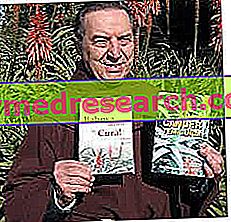Generality
Recently a new, supposedly natural cure for cancer has been brought to the attention of the community. The creator is such father Romano Zago (a Brazilian friar) and his "magic recipe" is composed of aloe (species Aloe arborescens Mill.), Natural honey and grappa.

Tumor and Cancer
The tumor, more properly called neoplasia, represents a pathological process characterized by an abnormal growth of a tissue, which continues even at the end of the triggering stimulus. This unregulated growth can subvert the normal functions of the affected tissue and / or create compression / obstruction disorders of nearby structures.
A tumor can affect various tissues, appear in various ways, be benign or malignant (in this case we talk about cancer or carcinoma) and evolve in different stages. As can be deduced, therefore, tumors are not all the same; gravity depends on the affected tissue and histological type, but the most dangerous form is always the cancerous one (malignant tumor). Usually, the cancer presents cells different from the original ones (with loss of tissue function), has a rapid and infiltrative growth (invades healthy tissues), tends to recur and creates metastases that affect other districts at a distance; the damage to the body is so high that it usually leads to death (if not treated). Being a particularly heterogeneous disease (since it affects all the tissues of the body), cancer still retains an extremely worrying epidemiology; in 2008 12.7 million new cases were registered worldwide, while deaths (decreasing) reached 60% of diagnoses.
The causes of tumors are probably of a mixed nature, with greater importance for certain risk factors such as: heredity, pre-existing episodes, incorrect nutrition and other abuses (smoking, alcoholism, etc.), sedentariness, oncogenic infections, radiation, hormones, etc.
The treatments available today are essentially surgical, chemotherapeutic and radiotherapeutic; an important weapon is represented by primary and secondary prevention (early diagnosis through screening tests), while in the near future the possibility of acting directly at the genetic level should significantly limit the dimensions of the problem, which as we have seen are considerable.
In addition to scientific research and in-depth study of conventional techniques, numerous alternative methods of dubious efficacy have been proposed (among the most well-known cases we remember the Kousmine Method, the cure with sodium bicarbonate, the one with amygdalin and the one with scorpion venom); more often than not, these practices are ineffective or even harmful, often motivated by a profound economic interest. On the other hand, due to a deontological obligation, contemporary medicine is required to verify the possible effectiveness of ALL the alternative systems proposed.
Having clarified this, let us try to understand in more detail WHAT IS Aloe arborescens !
Aloe arborescens
Aloe arborescens is a very common "succulent plant". Like all succulent plants, for reserve purposes, it has leaves full of liquids, from which a gel rich in phytotherapeutic properties can be obtained; famous, for example, is the gel made from the leaves of Aloe vera, a different species which (according to father Zago) would however lack the anticancer properties attributed to the arborescens.
Read the article on the properties of aloe gel (essentially moisturizing, healing and dermoprotective for external use, antioxidants, immunostimulants and anti-inflammatory for internal use)
Aloe arborescens is a perennial plant typical of desert regions (America and Africa) that reaches 3-4m in height. It develops with numerous ramifications and takes on the appearance of a large bush, with thorny green leaves up to 50 cm long and red-colored cluster flowers.
The medicinal properties of Aloe arborescens, known and already demonstrated, are similar to those of Aloe vera: laxative, healing, emollient, moisturizing, anti-inflammatory, immunostimulants and antioxidants.
As regards the possible healing power on cancer, the responsible active ingredient is a complex of anthraquinones, among which the most important is aloin and in particular its aglycone called aloe emodin . This is certainly not a new molecule to the attention of researchers; these substances have been studied in the laboratory (in vitro and in guinea pigs) for many years now, but the results are conflicting and inconclusive. While some studies have shown some usefulness in the fight against some types of cancer, on the other hand there is no lack of evidence about potential undesirable effects, such as the reduction of the activity of some anticancer drugs (in particular doxorubicin and paclitaxel ) and a role favoring the development of certain types of cancer (especially in the skin and colon). We must not forget how many natural substances are capable of eliminating or slowing down cancer cells in the laboratory; however, when leaving the test tube to transfer studies to guinea pigs or to humans, given the biological complexity of the latter, problems of inefficacy, toxicity and drug interactions emerge punctually.
Aloe to treat cancer
At this point, if the most skeptical readers asked themselves: "Are there or are NO scientific evidences VALIDATED on the properties of this formula?", I suggest to interrupt the reading since, at the moment, experimental or statistical data are NOT available at favor of the method of Father Romano Zago. The only supports for statements as exaggerated as unreliable on the anticancer properties of this "cure" derive from the timid scientific evidence on anthraquinones (see previous chapter) and from various positive testimonies of patients and specialists who were able to test their effectiveness.
In his book (without reporting scientific studies or verifiable statistical data!), Father Zago claims that a certain formula of aloe is able to cure cancer quickly and without side effects; moreover, on the home page of his website he says "You can cure cancer! The treatment of Father Romano Zago's Aloe arborescens has allowed many people to recover from cancer!" Personally, I believe that if the approach to disclosure had been a little more cautious, it would probably have had a decidedly less skeptical response from the scientific community. In any case it is understandable how for a seriously ill patient and for his family the hope is always the last to leave ... this makes them particularly receptive to messages of this type, as well as easy target of sellers of smoke and illusions to dear price.
The formula for the preparation of the compound is as simple as it is ancient. First of all, it is necessary to use an Aloe viva (therefore it is suggested to cultivate it in a vase). Then, cut 350g of leaves and blend them with 350g of natural honey; it is advisable to take the drink with a spoonful of grappa. Aloe smoothie can be stored BUT only for a very short time and absolutely never exposed to light and / or heat (so it is recommended to prepare it and consume it in the dark). NB . The only active ingredient is contained in aloe; honey has a sweetening function and vasodilator grappa.
The treatment with Aloe arborescens involves various stages of recruitment with pauses of about a day between these. Each phase requires the consumption of 3 120g cans (2 tablespoons 3 times a day). WARNING! Also on the dedicated website, it is specified that "If the treatment is abandoned when the cancer is not yet completely defeated and is neglected, it quickly recovers and soon returns more violent than before". In my opinion, this phrase serves as a sort of screen ...
In addition to this recipe, Father Romano Zago makes many references to other plants and active ingredients to be taken regularly; one, for example, is the amygdalin of bitter almond which, for the uninitiated, is a molecule containing CIANURO (from the friar considered toxic MA selective on cancer ... statement already widely denied in the past by the scientific community). Other natural remedies proposed against cancer are potassium bicarbonate and vitamin C, to be mixed with cold green tea to produce potassium ascorbate. A real diet is then offered which, not surprisingly, refers to the Kousmine method.
Conclusion
In conclusion, separate testimonies (on which certainty cannot be relied upon), therapy with Aloe arborescens has not scientifically demonstrated the presumed curative efficacy against cancer. Although the scientific literature on Aloe anthraquinones leaves room for some possible benefit (but also potential health damage!), It is unlikely that this product has the ability to eliminate a malignant tumor.
Finally, to those who insist on stating that the benefits of natural cancer treatments are overshadowed by the interests of pharmaceutical giants, I remember that for aloe there are "patents of use" (commercially exploitable ...); one of these, due to the use of aloe anthraquinones in oncology, involved the University of Padua, but there are others related for example to the use of acemannan (another immunostimulatory, antiviral molecule with potential antineoplastic properties extracted from the leaves of Aloe barbadensis).



